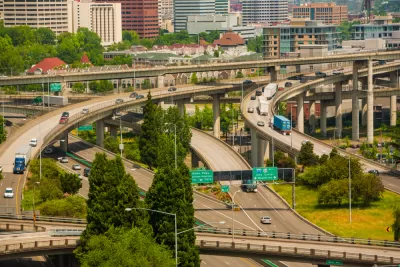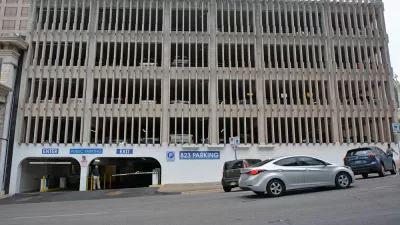Portland wants it both ways, but so do most places. But if Portland can't quit the car habit, which cities can?

Nadja Popovich and Brad Plumer in April wrote a feature-length, graphics- and image-laden article for the New York Times about Portland’s transportation planning agenda, posing a dilemma that could be repeated all over the country, but with special significance in Portland, a city known for innovative and climate-friendly approaches to land use and transportation planning.
Now the city faces a fresh challenge: To deal with traffic jams, state officials want to expand several major highways around Portland. Critics say that will only increase pollution from cars and trucks at a time when emissions need to fall, and fast.
This comes despite decades of efforts to get residents out of their cars, according to the article.
Over the past few decades, Oregon’s largest city has built an extensive light rail system, added hundreds of miles of bike lanes and adopted far-reaching zoning rules to encourage compact, walkable neighborhoods. Of the 40 largest U.S. metropolitan areas, Portland saw its residents drive the third-fewest miles per day in 2019, on average, behind only New York and Philadelphia.
The three highway projects identified in the article are the I-5 Rose Quarter Improvement Project, an interstate bridge replacement project sometimes referred to as the Columbia River Crossing, and a plan to add lanes and make other changes on I-205.
The political debate over the future of Oregon transportation planning centers on the conflicting goals of emissions reductions and congestion relief—in a city where transportation accounts for the vast majority of carbon dioxide emissions. The source article, linked below, includes discussions of induced demand, electric vehicles, transportation demand management, urban growth boundaries, and automobile dependency, and freeway removal, among other big planning concepts.
FULL STORY: Can Portland Be a Climate Leader Without Reducing Driving?

Alabama: Trump Terminates Settlements for Black Communities Harmed By Raw Sewage
Trump deemed the landmark civil rights agreement “illegal DEI and environmental justice policy.”

Study: Maui’s Plan to Convert Vacation Rentals to Long-Term Housing Could Cause Nearly $1 Billion Economic Loss
The plan would reduce visitor accommodation by 25% resulting in 1,900 jobs lost.

Planetizen Federal Action Tracker
A weekly monitor of how Trump’s orders and actions are impacting planners and planning in America.

Wind Energy on the Rise Despite Federal Policy Reversal
The Trump administration is revoking federal support for renewable energy, but demand for new projects continues unabated.

Passengers Flock to Caltrain After Electrification
The new electric trains are running faster and more reliably, leading to strong ridership growth on the Bay Area rail system.

Texas Churches Rally Behind ‘Yes in God’s Back Yard’ Legislation
Religious leaders want the state to reduce zoning regulations to streamline leasing church-owned land to housing developers.
Urban Design for Planners 1: Software Tools
This six-course series explores essential urban design concepts using open source software and equips planners with the tools they need to participate fully in the urban design process.
Planning for Universal Design
Learn the tools for implementing Universal Design in planning regulations.
Caltrans
Smith Gee Studio
Institute for Housing and Urban Development Studies (IHS)
City of Grandview
Harvard GSD Executive Education
Toledo-Lucas County Plan Commissions
Salt Lake City
NYU Wagner Graduate School of Public Service





























